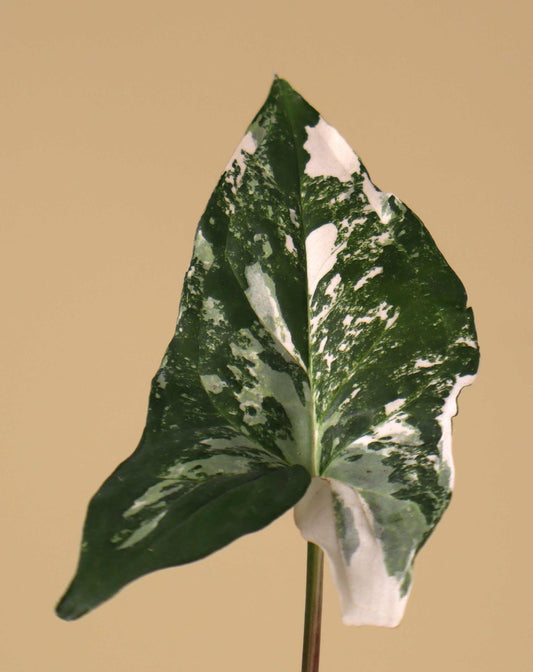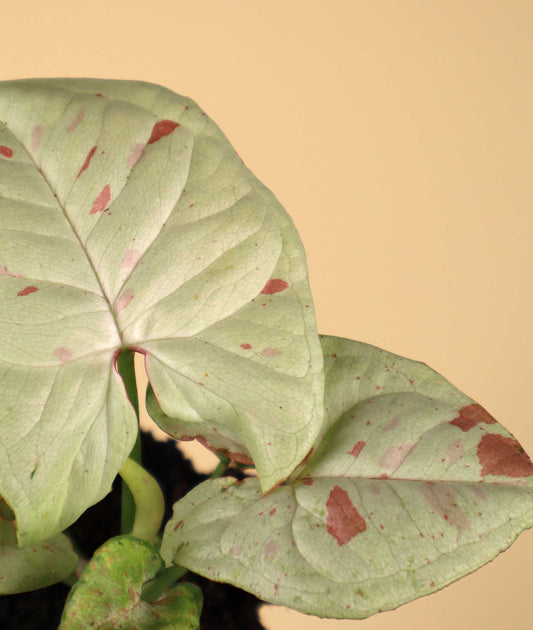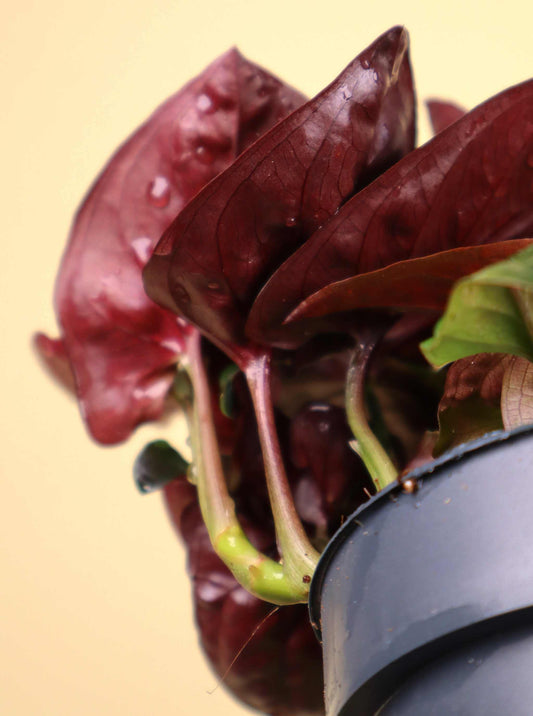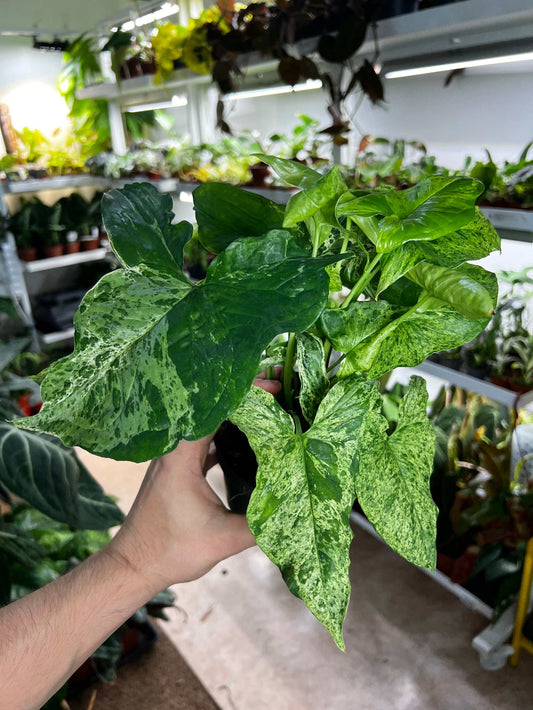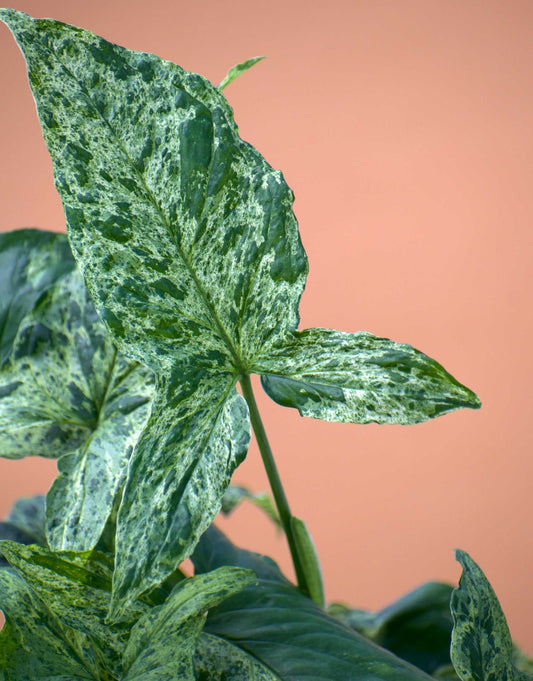Share
Arrowhead vine, a colorful and easy-care houseplant
Many of the well-known species from the syngonium genus have become common indoor houseplants. With their large leaves in shapes reminiscent of willows and their varying colors, from soft pink to white variegated, it is easy to understand why they have become popular. Easy to care for, fast growing and easy to propagate!
But if it is so easy to maintain, how do you best take care of it?

Syngonium albo variegata , an exclusive variety with beautiful white-variegated leaves
1. What kind of light does a Syngonium need?
Syngoniums thrive best in bright but indirect light. An east or west-facing window is often sufficient. Too much sun can cause brown spots on the leaves, especially in variegated varieties such as Syngonium albo variegata .
At the same time, too little light can cause the arrowhead vine to turn yellow and grow slowly. If the leaves become pale or new leaves are small, move the plant closer to the light! The arrowhead vine can tolerate direct sun in winter but should be kept protected from direct sun in summer.
If you have low light at home, we highly recommend that you consider grow lighting. You can read more about it and buy lamps here.
2. Location
Syngonium is not particularly picky, but likes to be protected from drafts and direct sun. Let it climb a moss stake or let the vines hang freely in a hanging basket. It looks great on a bookshelf, on a pedestal or in a hanging basket. If you want to keep it compact, you can cut back the vines occasionally, it often responds by becoming denser and finer.

Syngonium grows best on a plant support where the aerial roots can anchor themselves.
3. Soil & pot
Plant your arrowhead vine in an airy and well-drained soil. A mixture of finely ground coconut fiber, perlite and a little orchid bark works well, such as our aroid soil . Syngonium likes the soil to be kept slightly moist but not wet. It is better to water a little and often than to overwater and wait a long time.
The pot should be well-drained with several holes. The roots of the arrowhead vine are sensitive to rot and, like orchids, need pots with many holes in them. Using a transparent pot also allows you to keep an eye on the health of the roots and avoid guessing when it's time to repot!
You can buy pots for Syngonium here.
4. Transplantation
Repot about once a year, preferably in the spring. The arrowhead vine grows quickly and often fills the pot quickly with its roots. Choose a pot that is about the right size. (about 2-3 cm in diameter) larger and take the opportunity to cut it down if it has become spread out.
If you cut below a node, i.e. the place on the stem where new roots emerge, you can plant this cutting in a new pot. Arrowhead vine is one of the easiest plants to take cuttings from and they often root within a couple of weeks.
5. Common problems
Yellow leaves on the arrowroot vine can be caused by overwatering or poor light. Feel the soil, is it often wet? Reduce watering. The most common cause of yellow leaves on syngonium is overwatering, so watch out for that.
Brown leaf edges may indicate that the air is too dry. Feel free to shower the plant or use a humidifier. You can also use a damp surface to place the pot on, in our store we use watering mats.
Pests such as thrips or spider mites can appear, especially during the winter months. Keep an eye on the underside of the leaves and start treatment early if you notice anything suspicious. We recommend using beneficial insects as a treatment even before an outbreak occurs. Good beneficial insects for arrowhead vine are Montdorensis and Californicus .
You can read more about how to treat thrips and spider mites here.
6. How do you propagate Syngonium?
The arrowhead vine is super easy to propagate. Cut off a vine with at least one leaf and a node (where roots can form) and place in water or directly in soil. After a few weeks you will have a new plant. This makes it perfect for sharing, or building up a whole sea of Syngonium in different colors.
Frequently asked questions
Is syngonium dangerous for pets?
Syngonium is unfortunately toxic to both dogs and cats. It contains substances that can irritate the mouth and stomach if animals chew on the leaves. If you have pets who like to taste plants, it may be wise to place the arrowhead vine out of reach.
How many varieties are there?

There are many different varieties, some examples of the most popular right now are:
- Syngonium podophyllum 'Mottled'
- Syngonium podophyllum 'Milk Confetti'
- Syngonium podophyllum 'Neon'
- Syngonium podophyllum 'Albo variegata'
- Syngonium erythrophyllum
- Syngonium chiapense
- Syngonium wendlandii
In conclusion, syngonium is an easy-care and colorful plant with great variety. Whether you are drawn to pink tones, variegated leaves or just like stylish climbing vines, there is an arrowhead vine for you.



